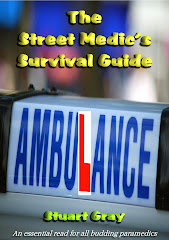Night shift: Seven calls; one by ambulance; one taken to a nearer tube station; two left at scene; three by car.
Stats: 1 faint; 1 DIB; 1 near faint; 1 tachycardia; 1 swollen foot; 1 chest pain; 1DOAB.
A muggy start and a trip out to help a fainted pregnant woman. The 25 year-old collapsed in the stupid heat of the underground as she made her way home. She was recovering well and being fanned by a staff member when I arrived. I took her to a nearer train station so that she could avoid sitting in the heat again for too much longer. I also advised her to get a fan and use it when she travelled. Things are set to get much worse over the next month or so.
Just as pizza was a possibility, I was dragged away to the north into an ugly, badly planned estate for a 72 year-old swearing man with DIB; he had a long history and was feeling the effects of the weather, just as thousands of others with COPD and asthma are, or will soon. The crew arrived within a few minutes and he was their patient from that moment on. He continued to swear and bemoan the people in charge of the estate... and doctors who told him that the electric fan in his house was as good as extra oxygen. I wonder if NASA knows this; maybe astronauts should be going into space with a little personal fan to keep them alive?
I’ve deliberately separated the faint from the near-faint because this second swooning call was an almost faint and not the real thing. The actress from the show ‘Love Never Dies’ was in the dressing room up in the top floor of the Adelphi Theatre when she collapsed and had to be laid down with her feet raised to avoid a little catastrophe. The pins and needles she felt were the result of her body panicking and the swoon may, or may not, have been caused by the heat, pregnancy, a virus or the height at which she and her colleagues had to dress and undress. This was a bit like the underwear shop I visited last week (not personally but on a call) – I was focussed on the patient and trying to avert my eyes, lest I see something I shouldn’t ought to (as they say on the boards).
The patient (let’s call her ‘Potty P’, which is what I dubbed her anyway) was taken down to ground level in the lift and out through the eager autograph-chasers at the Stage Door. I took her to hospital in the car.
Thankfully, it is quieter tonight, so the next call came in an hour or so later – it was for a 22 year-old male with ‘heart problems’. At that age, I expect to find nothing wrong with the patient, or drugs are involved – or panic but sometimes I get someone with a diagnosed condition, like this one. He had Cardiomyopathy and was worried about a tachycardic event he had but that had now settled down. He didn’t want to go to hospital, he just wanted checked out and reassured. Personally, I’d rather he’d gone to hospital but it’s his choice.
His ECG was all over the place but generally, his vital signs were normal and he looked fine, so I left him with the paperwork and a copy of the ECG. As I looked at the ECG and considered it he said ‘What looks strange to you guys, is normal for me’.
As soon as I was ready, another call came in and I was off to a police station to see a woman about a foot. She was a homeless person who’d gone to the police and reported her injury – a swollen foot – and this triggered a 999 call. I can’t believe we run on lights and sirens to things like this; it’s ridiculous because I’ve been to a few calls from this location and I had already sensed what was coming. Homeless people use the police to get an ambulance so that they can be taken to hospital and sleep in the waiting area.
The 33 year-old woman was sitting on the police station steps with a police officer looking after her. She had a very slightly swollen foot but this had been a problem for her for a number of years. Now she couldn’t stand on it, she claimed. This was strange because she walked – practically ran – to the car when I said I would drive her to A&E.
To be honest, I have no problem helping a homeless female to get off the street and into somewhere safe but if she’s been homeless for a ‘long time’ as she stated, then I suspect there’s a reason for that.
Another young person with chest pain but no related condition was the 24 year-old who sat on the pavement with ‘ten out of ten’ pain and asked a passer-by to call an ambulance. He denied any drug taking but admitted he’d been drinking ‘a little’. He also said he’d had this problem before – a fast heart rate – and I did an ECG in the street to get to the bottom of it.
He was non-diaphoretic and seemed perfectly comfortable, even though he had the equivalent level of pain as, say, a dust mite giving birth to an elephant. So, I took him to hospital in the car and my critics will all gather around the pond to have a go no doubt. The fact is, his ECG wasn’t screaming anything and he just didn’t come across as real. The hospital was two minutes away and I followed my instincts.
And my instincts were also followed for the 60 year-old male, ‘unconscious’ on a bus. The old drunk-on-a-bus (DOAB) card is being played every night at the moment... two reports in the space of a few minutes when I went to this one and I think, as is the norm, there will be a rash of DOAB calls throughout the Summer.
He was easy to wake and a bit stubborn but he got off the bus after a five minute debate in which he slurred stuff at me and I replied, hoping that I was making sense – ‘get off the bus’ seems pretty straight-forward, right?
Be safe.
Subscribe to:
Post Comments (Atom)















No comments:
Post a Comment